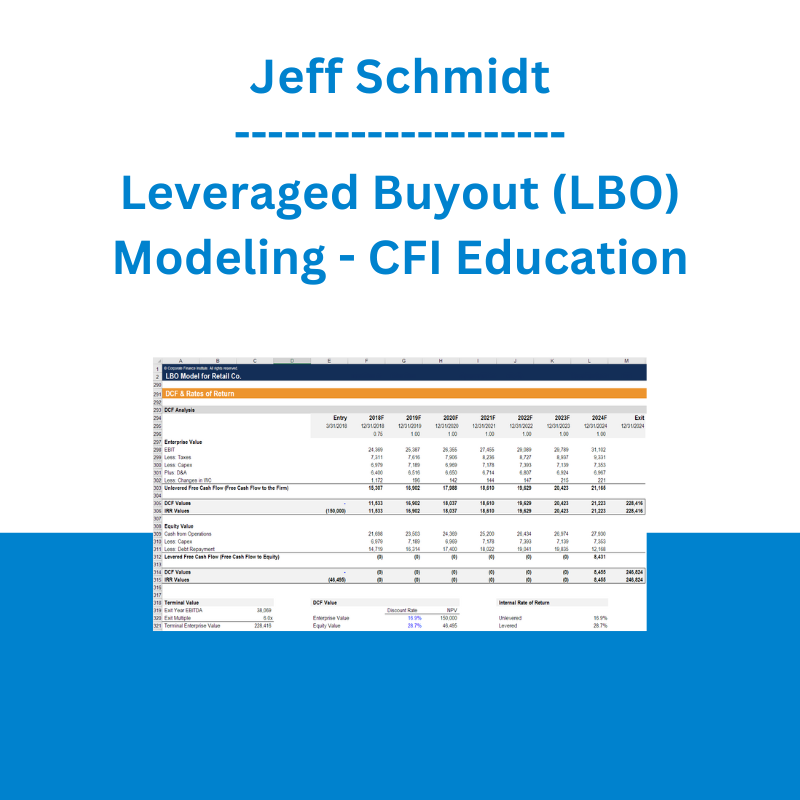*** Proof of Product ***
Exploring the Essential Features of “Jeff Schmidt – Leveraged Buyout (LBO) Modeling – CFI Education”
Leveraged Buyout (LBO) Modeling
CFI’s leveraged buyout modeling course demonstrates how to build an LBO model using an easy-to-follow, step-by-step curriculum.
- Identify the optimal characteristics of a good LBO candidate
- Model different and complex types of debt and interest expense
- Evaluate a prospective LBO by calculating its IRR and cash-on-cash return
Overview
Leveraged Buyout LBO Modeling Course Overview
A leveraged buyout model – or LBO – is one of the most common models built at investment banks and private equity firms. This advanced class covers modeling best practices, creating multiple scenarios for assumptions, modeling the income statement and cash flow statement, as well as a complex capital structure. Additionally, we cover the calculation of IRR and cash-on-cash returns, credit metrics and covenants, error checks, and a dashboard with multiple types of charts and sensitivity analysis.
Leveraged Buyout LBO Modeling Learning Objectives
By the end of the course, you should be able to:
- Define a leveraged buyout (LBO) and build a simple LBO model.
- Identify the characteristics of good candidates for LBO transactions.
- Examine a number of typical LBO exit strategies used by private equity firms.
- Outline the typical capital structure of an LBO transaction in terms of leverage and types of capital.
- Explain the characteristics of each piece of capital and its position and priority in the capital stack.
- Construct a full LBO model and evaluate the merits of the transaction by examining the equity returns.
Who Should Take this Leveraged Buyout LBO Modeling Course?
This LBO modeling course is most suitable for professionals working in investment banking and private equity, although it may also be useful for professionals in corporate development or other areas of finance.
Recommended Prep Courses
These preparatory courses are optional, but we recommend you to complete the stated prep course(s) or possess the equivalent knowledge prior to enrolling in this course:
- Excel Fundamentals – Formulas for Finance
- Building a 3 Statement Financial Model
- Business Valuation Modeling Part I
What you’ll learn
Introduction to Leveraged Buyouts
Course Introduction
Download Course Files
What is a Leveraged Buyout (LBO)
LBO Example
LBO Concept Summary
Compact LBO Complete Model Tour
Download the Compact LBO Model Template
Introduction to LBO Modeling
Model Inputs
LBO Model Exercise
Sources and Uses
Income Statement
Discretionary Cash Flow
Debt Schedule and Equity Return Exercise
Debt Schedule
Interest Expense
Equity Return
Chapter Summary
LBO Model Bells & Whistles
Data Table Introduction
Set Up the Data Table
Build the Data Table
Data Table Tips
Error Check Formatting
Conditional Formatting
Link Error Check to the Cover Page
Model Circularity
Combo Box
Circularity
Remove Circularity Errors
Hyperlink Model Tab to the Cover Page
Chapter Summary
Download the Completed Compact LBO Model
LBO Deep-Dive
Strategic vs Financial Buyers
LBO Candidates
Benefits and Risks of LBOs
LBO Valuation
Enterprise Value
Normalized EBITDA and Growing EBITDA
Exit Strategies
Return Drivers
Recent Market Data
Interactive Exercise 1
LBO Model Design
LBO Model Design
Cover Page
Full LBO Model Tour
Download the Full LBO Model Template
Sources & Uses
Purchase Price
Capital Structure
Sources and Uses Schedule Overview
Cover Page and Outputs Preview
Calculate Enterprise Value
Calculate Equity Offer Value
Uses and Sources of Cash
Interactive Exercise 2
Financing Assumptions
Financing Assumptions Introduction
Financing Fees
Complete Fees and Uses of Funds
Financing Assumptions Review
Interactive Exercise 3
Model Driver
Model Drivers Introduction
Main Model Drivers
Sparklines and Inputs Review
Interactive Exercise 4
Operational Schedules
Operational Schedules Introduction
Revenue Schedule
Cost Schedule
Operational Schedules Review
Interactive Exercise 5
Financial Statements
Financial Statements Introduction
Income Statement
Cash Flow Statement
Interactive Exercise 6
Midway Check-In
Capital Structure
Capital Structure Introduction
Senior Debt, Subordinated Debt, and Equity
Secured vs Unsecured Debt and Amortizing vs Non-Amortizing Debt
Debt Repayment Profiles
Credit Ratings
Fixed vs Floating Interest Rates
Interactive Exercise 7
Debt Schedule – Revolving Credit Line
Revolving Credit Line Introduction
Revolver Needs Analysis
Drawn Revolver Corkscrew
Drawn Revolver Interest Expense
Undrawn Revolver Corkscrew and Interest
Finishing the Revolver Schedule
Interactive Exercise 8
Debt Schedule – Term Loans
Term Loan Introduction
Term Loan A Assumptions
Term Loan A Required Repayment
Term Loan A Discretionary Repayment
Term Loan A Interest Expense
Term Loan B Corkscrew
Term Loan B Interest Expense
Interactive Exercise 9
Debt Schedule – Subordinated Debt
Sub Debt Introduction
Sub Debt Corkscrew
Sub Debt Interest Expense and PIK Accrual
Interest Income
Debt Summary
Debt Summary – Repayments and Ending Balances
Debt Summary – Interest Expense
Interactive Exercise 10
Equity Schedules
Equity Schedules Introduction
Equity Capital and Retained Earnings Corkscrews
Complete the Model
Output Schedules – Credit Metrics
Credit Metrics Introduction
Financial Metrics
Leverage Ratio Covenant
Leverage Ratio Covenant and Cushion
Debt Service Coverage Ratio Covenant
DSCR Cushion
Interactive Exercise 11
Output Schedules – Equity Returns
Equity Returns Metrics
Exit Equity Value
Dividends
Net Cash Flow Summary
IRR and Cash-on-Cash1
Model Wrap-Up
Interactive Exercise 12
Dashboards
Dashboards – Key LBO Metrics
Build Key LBO Metrics
Dashboard – Charts
EBITDA and Debt, Credit Metrics Charts
Return Attribution Chart
Returns by Horizon Chart
Dashboard – Data Table
Prepare the model for data tables
Build the First Data Table
Complete the Outputs tab
Model Circularity & Model Checks
Circularity Refresher
Add the Circularity Breaker
Circularity Summary
Cover Page Model Checks Part 1
Cover Page Model Checks Part 2
Model Review
Model Review Using Native Excel Tools
[Optional] Model Review Using Macabacus Tools
Excel Trace Precedents and Trace Dependents
[Optional] Macabacus Precedents and Dependents
Find the Errors
[Optional] Macabacus Visualization Tools
Flexing the Model
Interactive Exercise 13
Download the Completed Full LBO Model
[Optional] Library of Schedules
[Optional] Macabacus Library
[Optional] Name Scrubber, Remove Errors and Logos
[Optional] Preparing the RCL Schedule
[Optional] Uploading the Schedule to the Macabacus Library
Course Summary
Course Summary
Qualified Assessment
Qualified assessment
Please see the full list of alternative group-buy courses available here: https://lunacourse.com/shop/










 Money Miracle - George Angell - Use Other Peoples Money To Make You Rich
Money Miracle - George Angell - Use Other Peoples Money To Make You Rich  Oliver Velez - Essential Strategy Of Trade For Life
Oliver Velez - Essential Strategy Of Trade For Life